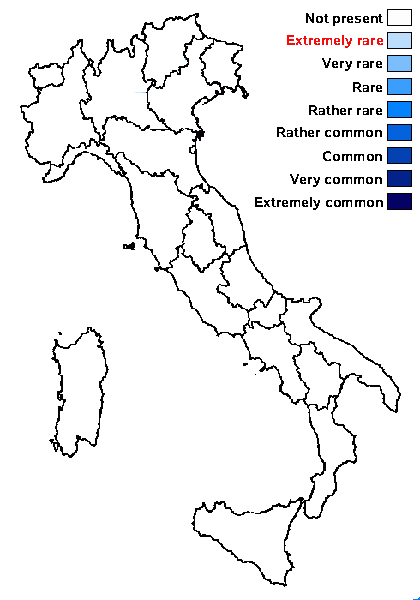Bacidina pycnidiata (Czarnota & Coppins) Czarnota & Guz.-Krzem.
Lichenologist, 50: 56, 2018 Basionym:. Basionym: Bacidia pycnidiata Czarnota & Coppins - Lichenologist, 38: 407, 2006
Synonyms:
Distribution:
Description: Thallus crustose, greyish green, finely granular, consisting of 20-30 µm wide goniocysts. Apothecia biatorine, (0.1-)0.2-0.5 mm across, sometimes tuberculate and to 0.6 mm across, with a pale, cream- to flesh-coloured, pale brownish, or rarely straw or (when old) orange-brown, flat to finally convex disc, and a thick to finally thin to excluded, concolorous or slightly brownish proper margin. Proper exciple well-developed, usually colourless or concolorous with hypothecium in inner part, prosoplectenchymatous throughout, the outer hyphae with cylindrical lumina, 5-7 µm wide, but the outermost cells often periclinally widened and sometimes to 10(-13) µm wide; epithecium partly hyaline, partly brown; hymenium colourless, 40-50 µm high; paraphyses mostly simple, the apical cells swollen; hypothecium colourless or dilute straw-orange in upper part. Asci 8-spored, clavate to cylindrical-clavate, the apical dome K/I+ dark blue with a pale, conical-pointed apical cushion (axial mass) never penetrating through the entire d-layer, the wall K/I-, but the thin outer gel K/I+ blue, Bacidia-type, 35-40 x 6-8 µm. Ascospores 3-septate, hyaline, needle-like, slightly curved or sigmoid, 35-50(-52) x 1-1.2 µm. Pycnidia whitish, cream or brownish when old, numerous, sessile, globose, 90-190 µm across. with a conspicuous, 120-200 µm long, sometimes markedly curved ostiolar neck. Macroconidia straight, transversely 3-5-septate, thread-like (30-)35-50(-55) x 0.5-0.8 µm. Photobiont chlorococcoid. Spot tests: thallus K-, C-, KC-, P-, UV-. Chemistry: thallus without lichen substances. Note: on corticolous bryophytes or directly on bark at the base of deciduous trees in humid, old forests, with several scattered records from northern and Central Europe; to be looked for in Italy.
Growth form: Crustose
Substrata: bark
Photobiont: green algae other than Trentepohlia
Reproductive strategy: mainly sexual

Predictive model
Growth form: Crustose
Substrata: bark
Photobiont: green algae other than Trentepohlia
Reproductive strategy: mainly sexual

Predictive model
 Index Fungorum
Index Fungorum
 GBIF
GBIF


